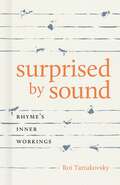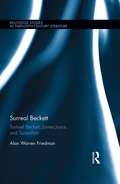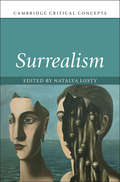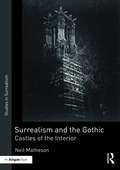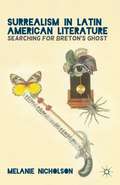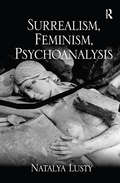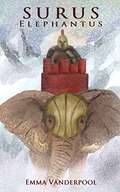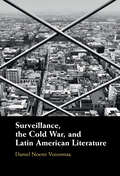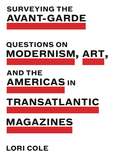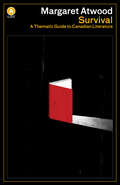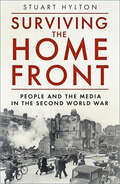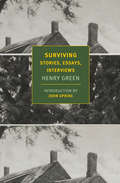- Table View
- List View
Surprised by Sin: The Reader in Paradise Lost
by Stanley FishFirst published in the late 1960s, in an era that no longer saw the need to choose between Milton's orthodoxy and heresy. With a new preface, the author revisits his thesis and considers the challenges offered by post-structuralism, late-20th-century historicism, and political criticism.
Surprised by Sound: Rhyme’s Inner Workings
by Roi TartakovskyIn Surprised by Sound, Roi Tartakovsky shows that the power of rhyme endures well into the twenty-first century even though its exemplary usages may differ from traditional or expected forms. His work uncovers the mechanics of rhyme, revealing how and why it remains a vital part of poetry with connections to large questions about poetic freedom, cognitive and psychoanalytic theories, and the accidental aspects of language.As a contribution to studies of sound in poetry, Surprised by Sound takes on two central questions: First, what is it about the structure of rhyme that makes it such a potent and ongoing source of poetic production and extrapoetic fascination? Second, how has rhyme changed and survived in the era of free verse, whose prototypical poetry is as hostile to poetic meter as it is to the artificial sound of rhyme, including the sound of rhythmic thumping at the end of every line? In response, Tartakovsky theorizes a new category of rhyme that he terms “sporadic.” Since it is not systematized or expected, sporadic rhyme can be a single, strongly resounding rhyme used suddenly in a free verse poem. It can also be an internal rhyme in a villanelle or a few scattered rhymes unevenly distributed throughout a longer poem that nevertheless create a meaningful cluster of words. Examining usages across varied poetic traditions, Tartakovsky locates sporadic rhyme in sources ranging from a sixteenth-century sonnet to a nonsensical, practically unperformable piece by Gertrude Stein and a 2007 MoveOn.org ad in the New York Times. With careful attention to the soundscapes of poems, Surprised by Sound demonstrates that rhyme’s enduring value lies in its paradoxical and unstable nature as well as its capacity for creating poetic, cognitive, and psychic effects.
Surreal Beckett: Samuel Beckett, James Joyce, and Surrealism (Routledge Studies in Twentieth-Century Literature)
by Alan Warren FriedmanSurreal Beckett situates Beckett‘s writings within the context of James Joyce and Surrealism, distinguishing ways in which Beckett forged his own unique path, sometimes in accord with, sometimes at odds with, these two powerful predecessors. Beckett was so deeply enmeshed in Joyce’s circle during his early Paris days (1928 - late 1930s) that James Knowlson dubbed them his "Joyce years." But Surrealism and Surrealists rivaled Joyce for Beckett’s early and continuing attention, if not affection, so that Raymond Federman called 1929-45 Beckett’s "surrealist period." Considering both claims, this volume delves deeper into each argument by obscuring the boundaries between theses differentiating studies. These received wisdoms largely maintain that Beckett’s Joycean connection and influence developed a negative impact in his early works, and that Beckett only found his voice when he broke the connection after Joyce’s death. Beckett came to accept his own inner darkness as his subject matter, writing in French and using a first-person narrative voice in his fiction and competing personal voices in his plays. Critics have mainly viewed Beckett’s Surrealist connections as roughly co-terminus with Joycean ones, and ultimately of little enduring consequence. Surreal Beckett argues that both early influences went much deeper for Beckett as he made his own unique way forward, transforming them, particularly Surrealist ones, into resources that he drew upon his entire career. Ultimately, Beckett endowed his characters with resources sufficient to transcend limitations their surreal circumstances imposed upon them.
Surreal Entanglements: Essays on Jeff VanderMeer’s Fiction (Routledge Studies in World Literatures and the Environment)
by Louise EconomidesThis edited collection approaches the most pressing discourses of the Anthropocene and posthumanist culture through the surreal, yet instructive lens of Jeff VanderMeer’s fiction. In contrast to universalist and essentializing ways of responding to new material realities, VanderMeer’s work invites us to re-imagine human subjectivity and other collectivities in the light of historically unique entanglements we face today: the ecological, technological, aesthetic, epistemological, and political challenges of life in the Anthropocene era. Situating these messy, multi-scalar, material complexities of life in close relation to their ecological, material, and colonialist histories, his fiction renders them at once troublingly familiar and strangely generative of other potentialities and insight. The collection measures VanderMeer’s work as a new kind of speculative surrealism, his texts capturing the strangeness of navigating a world in which "nature" has become radically uncanny due to global climate change and powerful bio-technologies. The first collection to survey academic engagements with VanderMeer, this book brings together scholars in the fields of environmental literature, science fiction, genre studies, American literary history, philosophy of technology, and digital cultures to reflect on the environmentally, culturally, aesthetically, and politically central questions his fiction poses to predominant understandings of the Anthropocene.
Surrealism (Cambridge Critical Concepts)
by Natalya LustyThis book examines the salient ideas and practices that have shaped Surrealism as a protean intellectual and cultural concept that fundamentally shifted our understanding of the nexus between art, culture, and politics. By bringing a diverse set of artistic forms and practices such as literature, manifestos, collage, photography, film, fashion, display, and collecting into conversation with newly emerging intellectual traditions (ethnography, modern science, anthropology, and psychoanalysis), the essays in this volume reveal Surrealism's enduring influence on contemporary thought and culture alongside its anti-colonial political position and international reach. Surrealism's fascination with novel forms of cultural production and experimental methods contributed to its conceptual malleability and temporal durability, making it one of the most significant avant-garde movements of the twentieth century. The book traces how Surrealism's urgent political and aesthetic provocations have bequeathed an important legacy for recent scholarly interest in thing theory, critical vitalism, new materialism, ontology, and animal/human studies.
Surrealism and the Gothic: Castles of the Interior (Studies in Surrealism)
by Neil MathesonSurrealism and the Gothic is the first book-length analysis of the role played by the gothic in both the initial emergence of surrealism and at key moments in its subsequent development as an art and literary movement. The book argues the strong and sustained influence, not only of the classic gothic novel itself – Ann Radcliffe, Charles Maturin, Matthew Lewis, etc. – but also the determinative impact of closely related phenomena, as with the influence of mediumism, alchemy and magic. The book also traces the later development of the gothic novel, as with Bram Stoker’s Dracula, and its mutation into such works of popular fiction as the Fantômas series of Marcel Allain and Pierre Souvestre, enthusiastically taken up by writers such as Apollinaire and subsequently feeding into the development of surrealism. More broadly, the book considers a range of motifs strongly associated with gothic writing, as with insanity, incarceration and the ‘accursed outsider’, explored in relation to the personal experience and electroshock treatment of Antonin Artaud. A recurring motif of the analysis is that of the gothic castle, developed in the writings of André Breton, Artaud, Sade, Julien Gracq and other writers, as well as in the work of visual artists such as Magritte.
Surrealism in Greece
by Nikos StabakisIn the decades between the two World Wars, Greek writers and artists adopted surrealism both as an avant-garde means of overturning the stifling traditions of their classical heritage and also as a way of responding to the extremely unstable political situation in their country. Despite producing much first-rate work throughout the rest of the twentieth century, Greek surrealists have not been widely read outside of Greece. This volume seeks to remedy that omission by offering authoritative translations of the major works of the most important Greek surrealist writers. Nikos Stabakis groups the Greek surrealists into three generations: the founders (such as Andreas Embirikos, Nikos Engonopoulos, and Nicolas Calas), the second generation, and the Pali Group, which formed around the magazine Pali. For each generation, he provides a very helpful introduction to the themes and concerns that animate their work, as well as concise biographies of each writer. Stabakis anthologizes translations of all the key surrealist works of each generation--poetry, prose, letters, and other document--as well as a selection of rarer texts. His introduction to the volume places Greek surrealism within the context of the international movement, showing how Greek writers and artists used surrealism to express their own cultural and political realities. In the decades between the two World Wars, Greek writers and artists adopted surrealism both as an avant-garde means of overturning the stifling traditions of their classical heritage and also as a way of responding to the extremely unstable political situation in their country. Despite producing much first-rate work throughout the rest of the twentieth century, Greek surrealists have not been widely read outside of Greece. This volume seeks to remedy that omission by offering authoritative translations of the major works of the most important Greek surrealist writers. Nikos Stabakis groups the Greek surrealists into three generations: the founders (such as Andreas Embirikos, Nikos Engonopoulos, and Nicolas Calas), the second generation, and the Pali Group, which formed around the magazine Pali. For each generation, he provides a very helpful introduction to the themes and concerns that animate their work, as well as concise biographies of each writer. Stabakis anthologizes translations of all the key surrealist works of each generation - poetry, prose, letters, and other documents - as well as a selection of rarer texts. His introduction to the volume places Greek surrealism within the context of the international movement, showing how Greek writers and artists used surrealism to express their own cultural and political realities.
Surrealism in Latin American Literature
by Melanie NicholsonCharting surrealism in Latin American literature from its initial appearance in Argentina in 1928 to the surrealist-inspired work of several writers in the 1970s, Melanie Nicholson argues that surrealism has exercised a significant and positive influence over twentieth-century Latin American literature, particularly poetry.
Surrealism, Feminism, Psychoanalysis
by Natalya LustyHow did women Surrealists such as Leonora Carrington and Claude Cahun take up the question of female identity in terms of their own aesthetic and intellectual practice? What was the response of women analysts such as Joan Riviere to Freud's psychoanalytic construction of femininity? These are among the questions that Natalya Lusty brings to her sophisticated and theoretically informed investigation into the appropriation of 'the feminine' by the Surrealist movement. Combining biographical and textual methods of analysis with historically specific discussions of related cultural sites such as women's magazines, fashion, debutante culture, sexology, modernist lesbian subculture, pornography, and female criminality, the book examines the ambiguities and blind spots that haunt the work of more central figures such as André Breton, Georges Bataille, Jacques Lacan, Walter Benjamin, and the Surrealist photographer Hans Bellmer. Lusty's examination of a series of psychoanalytic Surrealist themes, including narcissism, fantasy, masquerade, perversion, and 'the double', illuminates a modernist preoccupation with the crisis of subjectivity and representation and its ongoing relevance to more recent work by Cindy Sherman and Judith Butler. Her book is an important contribution to modernist studies that will appeal to scholars and students working across a diverse range of fields, including literary studies, gender studies, visual culture, cultural studies, and cultural history.
Surus: Fābula Bellī et Elephanti
by Emma VanderpoolSurus the Elephant is the mightest and largest elephant in the army and as such is Hannibal's favorite. The Carthaginian general has plans that will take his army, including men and elephants alike, from Africa, through Spain and Gaul, and directly into Roman territory. This novella recounts the stories of Surus the Elephant and his Mahout (elephant trainer) Mago as they recount their dangerous journey together to Italy. This book contains some 3,000 words total. Of which, there are 130 different words (excluding proper nouns). The book, with sheltered vocabulary and unsheltered grammar, is geared towards intermediate students.
Surveillance, the Cold War, and Latin American Literature
by Daniel Noemi VoionmaaSurveillance, the Cold War, and Latin American Literature examines secret police reports on Gabriel García Márquez, Pablo Neruda, Octavio Paz, Elena Poniatowska, José Revueltas, Otto René Castillo, Carlos Cerda, and other writers, from archives in Mexico, Chile, Guatemala, Uruguay, the German Democratic Republic, and the USA. Combining literary and cultural analysis, history, philosophy, and history of art, it establishes a critical dialogue between the spies' surveillance and the writers' novels, short stories, and poems, and presents a new take on Latin American modernity, tracing the trajectory of a modern gaze from the Italian Renaissance to the Cold War. It traces the origins of today's surveillance society with sense of urgency and consequence that should appeal to academic and non-academic readers alike throughout the Americas, Europe and beyond.
Surveying the Avant-Garde: Questions on Modernism, Art, and the Americas in Transatlantic Magazines (Refiguring Modernism #26)
by Lori ColeSurveying the Avant-Garde examines the art and literature of the Americas in the early twentieth century through the lens of the questionnaire, a genre as central as the manifesto to the history of the avant-garde.Questions such as “How do you imagine Latin America?” and “What should American art be?” issued by avant-garde magazines like Imán, a Latin American periodical based in Paris, and Cuba’s Revista de Avance demonstrate how editors, writers, and readers all grappled with the concept of “America,” particularly in relationship to Europe, and how the questionnaire became a structuring device for reflecting on their national and aesthetic identities in print. Through an analysis of these questionnaires and their responses, Lori Cole reveals how ideas like “American art,” as well as “modernism” and “avant-garde,” were debated at the very moment of their development and consolidation. Unlike a manifesto, whose signatories align with a single polemical text, the questionnaire produces a patchwork of responses, providing a composite and sometimes fractured portrait of a community. Such responses yield a self-reflexive history of the era as told by its protagonists, which include figures such as Gertrude Stein, Alfred Stieglitz, Jean Toomer, F. T. Marinetti, Diego Rivera, and Jorge Luis Borges.The book traces a genealogy of the genre from the Renaissance paragone, or “comparison of the arts,” through the rise of enquêtes in the late nineteenth century, up to the contemporary questionnaire, which proliferates in art magazines today. By analyzing a selection of surveys issued across the Atlantic, Cole indicates how they helped shape artists’ and writers’ understanding of themselves and their place in the world.Derived from extensive archival research, this book reorients our understanding of modernism as both hemispheric and transatlantic by narrating how the artists and writers of the period engaged in aesthetic debates that informed and propelled print communities in Europe, the United States, and Latin America. Scholars of modernism and the avant-garde will welcome Cole’s original and compellingly crafted work.
Surveying the Avant-Garde: Questions on Modernism, Art, and the Americas in Transatlantic Magazines (Refiguring Modernism)
by Lori ColeSurveying the Avant-Garde examines the art and literature of the Americas in the early twentieth century through the lens of the questionnaire, a genre as central as the manifesto to the history of the avant-garde.Questions such as “How do you imagine Latin America?” and “What should American art be?” issued by avant-garde magazines like Imán, a Latin American periodical based in Paris, and Cuba’s Revista de Avance demonstrate how editors, writers, and readers all grappled with the concept of “America,” particularly in relationship to Europe, and how the questionnaire became a structuring device for reflecting on their national and aesthetic identities in print. Through an analysis of these questionnaires and their responses, Lori Cole reveals how ideas like “American art,” as well as “modernism” and “avant-garde,” were debated at the very moment of their development and consolidation. Unlike a manifesto, whose signatories align with a single polemical text, the questionnaire produces a patchwork of responses, providing a composite and sometimes fractured portrait of a community. Such responses yield a self-reflexive history of the era as told by its protagonists, which include figures such as Gertrude Stein, Alfred Stieglitz, Jean Toomer, F. T. Marinetti, Diego Rivera, and Jorge Luis Borges.The book traces a genealogy of the genre from the Renaissance paragone, or “comparison of the arts,” through the rise of enquêtes in the late nineteenth century, up to the contemporary questionnaire, which proliferates in art magazines today. By analyzing a selection of surveys issued across the Atlantic, Cole indicates how they helped shape artists’ and writers’ understanding of themselves and their place in the world.Based on extensive archival research, this book reorients our understanding of modernism as both hemispheric and transatlantic by narrating how the artists and writers of the period engaged in aesthetic debates that informed and propelled print communities in Europe, the United States, and Latin America. Scholars of modernism and the avant-garde will welcome Cole’s original and compellingly crafted work.
Survival
by Margaret AtwoodWhen first published in 1972, Survival was considered the most startling book ever written about Canadian literature. Since then, it has continued to be read and taught, and it continues to shape the way Canadians look at themselves. Distinguished, provocative, and written in effervescent, compulsively readable prose, Survival is simultaneously a book of criticism, a manifesto, and a collection of personal and subversive remarks. Margaret Atwood begins by asking: "What have been the central preoccupations of our poetry and fiction?" Her answer is "survival and victims."Atwood applies this thesis in twelve brilliant, witty, and impassioned chapters; from Moodie to MacLennan to Blais, from Pratt to Purdy to Gibson, she lights up familiar books in wholly new perspectives.From the Trade Paperback edition.
Survival Media: The Politics and Poetics of Mobility and the War in Sri Lanka (Mobility & Politics)
by S. PereraThrough the narratives and movements of survivors of the war in Lanka these interconnected essays develop the concept of 'survival media' as embodied and expressive forms of mobility across borders.
Survival and Development of Language Communities
by F. Xavier VilaToo small to be big, but also too big to be really small, medium-sized language communities (MSLCs) face their own challenges in a rapidly globalising world where multilingualism and mobility seem to be eroding the old securities that the monolingual nation states provided. The questions to be answered are numerous: What are the main areas in which the position of these languages is actually threatened? How do these societies manage their diversity (both old and new)? Has state machinery really become as irrelevant in terms of language policy as their portrayals often suggest? This book explores the responses to these and other challenges by seven relatively successful MSLCs, so that their lessons can be applied more generally to other languages striving for long term survival.
Survival of the Fireflies (Univocal)
by Georges Didi-HubermanSeeking out the minor lights of friendship in a time of fascism Dante once spoke, in his Divine Comedy, of the miniscule lights, in the twenty-sixth canto of the Inferno, who, contrary to the great lights that shined bright within the sublime circles of Paradise, frailly wandered in the somber pockets of glimmering light within the darkness. Pliny the Elder was once preoccupied by a type of fly named pyrallis or pyrotocon, which was only able to fly within fire: &“as long as it remains in the fire, it can fly; when its flight takes it out too far a distance, it dies.&” Through his readings of Dante, Pasolini, Walter Benjamin, and others, Georges Didi-Huberman seeks again to understand this strange, minor light, the signals of small beings in search of love and friendship. Their flickering presence serves as a counterforce to the blinding sovereign power that Giorgio Agamben calls The Kingdom and the Glory, that artificial brilliance that once surrounded dictators and today emanates from every screen. In this timely reflection, much needed in our time of excessive light, Didi-Huberman&’s Survival of the Fireflies offers a humble yet powerful image of individual hope and desire: the firefly-image.
Survival: A Thematic Guide to Canadian Literature (A List)
by Margaret AtwoodWhen first published in 1972, Survival was considered the most startling book ever written about Canadian literature. Since then, it has continued to be read and taught, and it continues to shape the way Canadians look at themselves. Distinguished, provocative, and written in effervescent, compulsively readable prose, Survival is simultaneously a book of criticism, a manifesto, and a collection of personal and subversive remarks. Margaret Atwood begins by asking: "What have been the central preoccupations of our poetry and fiction?" Her answer is "survival and victims."Atwood applies this thesis in twelve brilliant, witty, and impassioned chapters; from Moodie to MacLennan to Blais, from Pratt to Purdy to Gibson, she lights up familiar books in wholly new perspectives. This new edition features a foreword by the author.
Survivance, Sovereignty, and Story
by Lisa King Joyce Rain Anderson Rose Gubele"Focusing on the importance of discussions about sovereignty and of the diversity of Native American communities, Survivance, Sovereignty, and Story offers a variety of ways to teach and write about indigenous North American rhetorics.These essays introduce indigenous rhetorics, framing both how and why they should be taught in US university writing classrooms. Contributors promote understanding of American Indian rhetorical and literary texts and the cultures and contexts within which those texts are produced. Chapters also supply resources for instructors, promote cultural awareness, offer suggestions for further research, and provide examples of methods to incorporate American Indian texts into the classroom curriculum.Survivance, Sovereignty, and Story provides a decolonized vision of what teaching rhetoric and writing can be and offers a foundation to talk about what rhetoric and pedagogical practice can mean when examined through American Indian and indigenous epistemologies and contemporary rhetorics."
Survivance, Sovereignty, and Story: Teaching American Indian Rhetorics
by Lisa King Joyce Rain Anderson Rose GubeleFocusing on the importance of discussions about sovereignty and of the diversity of Native American communities, Survivance, Sovereignty, and Story offers a variety of ways to teach and write about indigenous North American rhetorics. These essays introduce indigenous rhetorics, framing both how and why they should be taught in US university writing classrooms. Contributors promote understanding of American Indian rhetorical and literary texts and the cultures and contexts within which those texts are produced. Chapters also supply resources for instructors, promote cultural awareness, offer suggestions for further research, and provide examples of methods to incorporate American Indian texts into the classroom curriculum. Survivance, Sovereignty, and Story provides a decolonized vision of what teaching rhetoric and writing can be and offers a foundation to talk about what rhetoric and pedagogical practice can mean when examined through American Indian and indigenous epistemologies and contemporary rhetorics. Contributors include Joyce Rain Anderson, Resa Crane Bizzaro, Qwo-Li Driskill, Janice Gould, Rose Gubele, Angela Haas, Jessica Safran Hoover, Lisa King, Kimberli Lee, Malea D. Powell, Andrea Riley-Mukavetz, Gabriela Raquel Ríos, and Sundy Watanabe.
Surviving in My World: Growing Up Dalit in Bengal
by Sekhar Bandyopadhyay Manohar Mouli Biswas Angana Dutta Jaideep SarangiIT GIVES US great pleasure to present the English translation of Manohar Mouli Biswas's Bengali autobiography Amar Bhubane Ami Benche Thaki (2013). The book consists of the autobiography and a detailed interview of the author; the latter attempts to bridge the gap between Biswas's days of struggle as a dalit child labourer, as narrated in the autobiography, and his later (so far unrecorded) life as an accomplished dalit literary activist, as one of the leading members of the Bangla Dalit Sahitya Sanstha. His auto¬biography surprises us by its inherent truth and beauty.
Surviving the Crossing: (Im)migration, Ethnicity, and Gender in Willa Cather, Gertrude Stein, and Nella Larsen (Literary Criticism and Cultural Theory)
by Jessica RabinBy examining the fiction of three women modernists--Willa Cather, Gertrude Stein, and Nella Larsen--this book complicates binary paradigms of national, gender, and ethnic identities in the interwar period. In place of essentializing categories of identity, Jessica Rabin explores the liberating and dislocating ramifications of using multiple subject positions as a means of representing identity. While these three authors have been studied in non-intersecting categories (pioneer literature, high modernism, and the Harlem Renaissance, respectively), Jessica Rabin traces their similarities, showing how the dispersal of fixed identities are facilitated by the language of fiction.
Surviving the Home Front: The People and the Media in the Second World War
by Stuart HyltonTerrifying raids, thousands of bombs and countless petrified inhabitants of Britain’s busiest cities. These are the prevailing images of the Blitz and the Home Front in the Second World War. However, for the people who experienced it, it was so much more and affected every aspect of their existence.Surviving the Home Front explores through contemporary newspaper reports and advertisements the effect the Blitz had on issues as varied as fashion, food, transport and more. It explores how facets of humanity showed themselves through individual tales of heroism, eccentricity and humour, but above all Stuart Hylton shows how the irrepressible spirit of the British people overcame a period of harsh austerity combined with the fresh terrors that appeared in their skies almost every night.
Surviving: Stories, Essays, Interviews
by Henry GreenA collection of short stories, journalism pieces, and various writings by the esteemed twentieth-century English novelist Henry Green.Surviving presents a miscellany of Henry Green&’s writing, and is as reflective of his extraordinary and unclassifiable genius for the word as any of his great novels from Living to Loving to Nothing. Readers will find remarkable stories from the 1920s and 1930s; Green&’s telling of his time in the London Fire Brigade during the Blitz; a short, unpublished play, Journey out of Spain; journalism; and the hilarious interview that Terry Southern conducted for The Paris Review. Edited by the novelist Matthew Yorke, Green&’s grandson, Surviving also includes a memoir by Green&’s son, Sebastian Yorke, that is a brilliant portrait of this maverick master.

